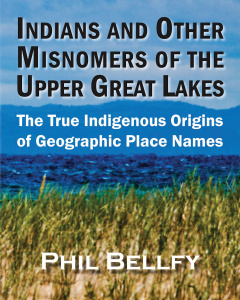 Indians and Other Misnomers of the Upper Great Lakes is really quite a simple but important book that must have taken an enormous amount of work and research to produce. I also personally thought it profoundly ironic for multiple reasons. Basically, as the subtitle states the book simply lists names that were given to places in the Great Lakes area by the indigenous people that are still used today. There is a chapter for each Great Lake state and Ontario listing the indigenous names you will find on maps, highway signs, city limits, lakes and the meaning of each name in it’s native tongue. Michigan has nearly a 100 Native American place names. They include Manistee which means Crooked River, Naubinway = Place of Echo, Munising = Island in the Lake, Muskegon = Swampy, Pinconning = Potato Place, and Menominee = Wild Rice People to name a few. It comes as a revelation when one discovers how many Native American words were used or appropriated by Europeans throughout the Great Lakes area in naming geographic features or places.
Indians and Other Misnomers of the Upper Great Lakes is really quite a simple but important book that must have taken an enormous amount of work and research to produce. I also personally thought it profoundly ironic for multiple reasons. Basically, as the subtitle states the book simply lists names that were given to places in the Great Lakes area by the indigenous people that are still used today. There is a chapter for each Great Lake state and Ontario listing the indigenous names you will find on maps, highway signs, city limits, lakes and the meaning of each name in it’s native tongue. Michigan has nearly a 100 Native American place names. They include Manistee which means Crooked River, Naubinway = Place of Echo, Munising = Island in the Lake, Muskegon = Swampy, Pinconning = Potato Place, and Menominee = Wild Rice People to name a few. It comes as a revelation when one discovers how many Native American words were used or appropriated by Europeans throughout the Great Lakes area in naming geographic features or places.
I can’t help but find it ironic that the very people throwing Native Americans off their land would keep the original place names that originated with the indigence people. Or, that Indian Agent Henry Rowe Schoolcraft who signed treaties with various tribes that resulted in the loss of their homeland then named ten new counties in Michigan with “Indian Sounding ” names such as Allegan, Oscoda, and Tuscola. Lastly there were the indigenous children who were taken from their homes and sent to schools for the purpose of stripping them of their culture. They were forbidden to speak their native tongue while Europeans thought nothing odd in adopting indigenous words for places Native American children were not allowed to utter.
In addition to the indigenous geographic names found in each of the states and Ontario there is a lengthy alphabetical listing of all the indigenous place names, treaty signers, and untranslatable words used as place names. This is followed by a listing of treaties in the Great Lakes area, the date signed, the location of the signing, and the tribe or tribes involved. Of special note the land involved in each treaty is keyed to the maps preceding the chapters on each state. Indians and Other Misnomers of the Upper Great Lakes is an important and fascinating book that reminds the reader that the culture and language of Native Americans is still with us today. It enriches our language, and the words alone make clear how long this land has been revered and cherished.
Read the original review in Michigan In Books Blog
Indians and Other Misnomers of the Upper Great Lakes: The True Indigenous Origins of Geographic Place Names by Phil Bellfy. Ziibi Press, 2023, 152p., $25.95 pb.





